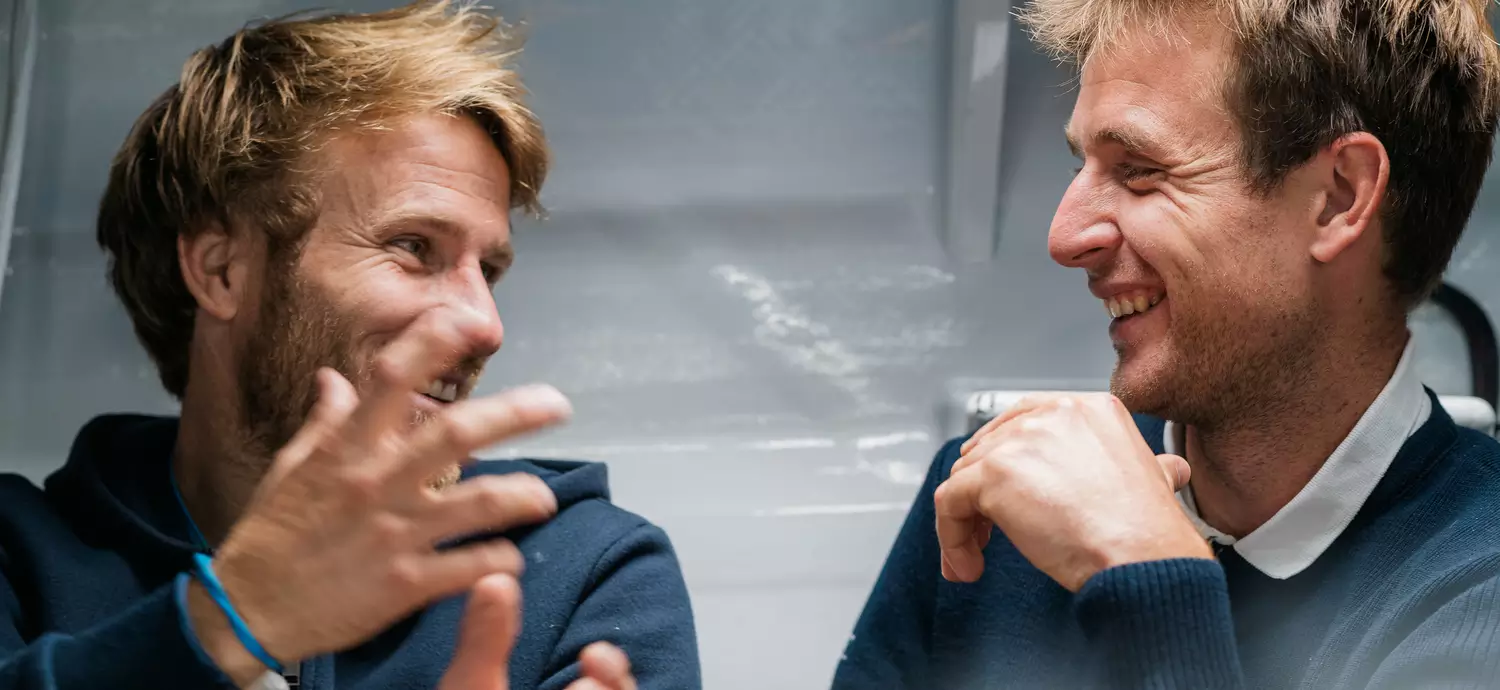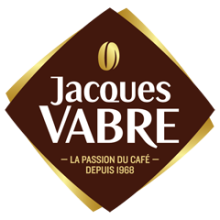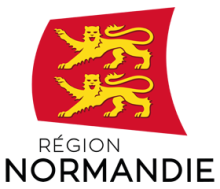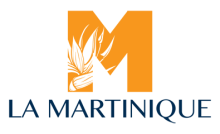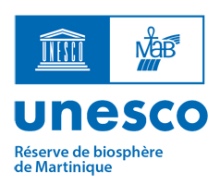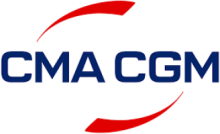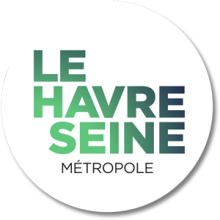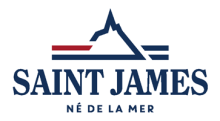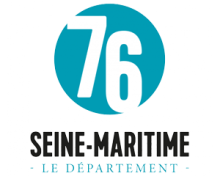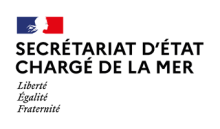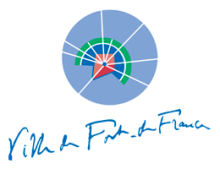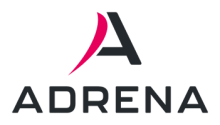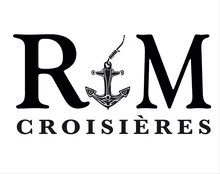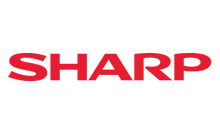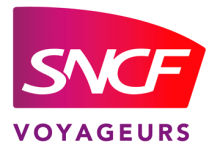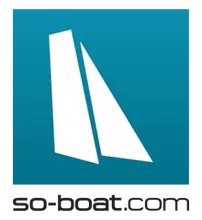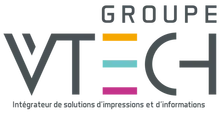The trampoline nets are fully stretched and taut and anyone stepping aboard is delighted, as this is a real privilege. Everyone wants to enter this strange universe and the visits come one after another aboard SVR Lazartigue. After an autograph session in the big tent set up by the ULTIM class, François and Tom are back on board their boat. A few memories for the Transat Jacques Vabre Normandie Le Havre social network team and the photographer is adjusting his flash to get a photo of the atmosphere. Then, it was our turn.
We just had time to take a look around this blue, technological gem, where there has been an obsession with aerodynamics, which has led this ULTIM to take things further than any other. The channels for the lines, the hydraulic cables, deck hardware… everything is covered over with sheeting to smooth the surface out and avoid any disturbances. All that remains is the huge genoa pulley system in the middle of the trampoline, with her stainless steel sheave, which gives us an inkling of the forces at play here.
Inside, it is in keeping with this. You enter via the small domes, sliding in vertically like a fighter pilot. In the central area, there is a well-cushioned reclining watch seat with the computer screen in front and the lines at your feet. To the rear, the coffee grinder winches have been raised to allow you to see outside when turning the two huge carbon winches, which each cost the price of a decent little car.
At the foot of the go-kart style wheel at the helm, there are two other wheels that the driver can turn with his feet. That is the control for the central daggerboard flap, the famous ray wing, which allows the hull to take off. “To regulate flight, it is much easier than playing around with the sheets, so we use that a lot,” explained Tom.
How do you feel with 48 hours to go to the start?
Tom: We’re remaining fully concentrated and don’t feel any apprehension. We’re starting to get a good look now at the weather. We know it is going to be pretty rough during the first few days of the race. As we get closer to the start, we can be more precise about the wind strength, sea state, which sails to use and the timing of our manoeuvres. That means we have to concentrate and we can imagine what it is going to be like during the first 48 hours of racing.
Where do you think you will be by Tuesday lunchtime?
Tom thinks it over: Off Portugal more or less.
François: They’re not going to be the fastest conditions. We would be able to sail sooner off Portugal if conditions were different, but it’s not looking too bad.
Do you think such winter weather and going from the transatlantic race to the round the world race is still a good idea?
François: To prepare well for the round the world voyage, we need to get in as much sailing as we can and in all sorts of rough weather. We need to sail too in a competition and there’s nothing better than the Transat Jacques Vabre, as that is a goal in itself. Of course, there is some risk, but that is the case too when training and it is acceptable.
Heading out towards a front passing over the sail area, and changing tack behind it in heavy seas… Is that something ULTIMs have already done?
Tom: Not a lot this year. In the Fastnet, it was quite windy though. (40 knots in the Channel - editor). It was great getting out there in rough weather. It can be complicated, but that is when we make progress, because we are racing. Would we have done that while training? Getting out there in windy conditions in the Solent and carrying out a series of tacks towards a front? I’m not convinced.
François: It’s clear it is going to be tricky at the start and we can’t do anything silly, but just as in the Route du Rhum, we can see that the speed of these boats will once again be an asset to get out of this complex weather system. It is indeed more comfortable, although I don’t know if that is the right word, when you are getting away from North Atlantic weather patterns in the autumn.
(François is talking about a second low-pressure system, which is due to cross the Atlantic on Tuesday-Wednesday, but which the ULTIM boats should be able to dodge - editor)
Two years ago, you were still discovering this trimaran. How far have you come since then?
Tom: We are still not at 100%, as on a boat of this size, two years is not enough to deal with all the tiny adjustments and settings. We have moved up a step however since the early days. In 2021, the technical aspects were much more important. It was a technical challenge getting a trimaran that was reliable enough to cross the Atlantic and we were proud to have achieved that with the team. Since then, it is the notion of performance that has taken over. We are now much more convinced about certain settings…
François: You can spend your whole life trying to get the most out of these boats. But there has been a lot of progress. In the beginning, you make rapid progress and then you feel like you have reached a certain level. Now, we are starting to turn the corner and are able to work on all the details.
Will you be testing things again in this Coffee race?
François: Some adjustments, yes, but the systems are not in place. It’s marginal. A few months ago, we said that the boat should be at the start of the Transat Jacques Vabre in the same configuration as for the round the world voyage. That doesn’t mean that if we see something that doesn’t work well, we won’t change it.
Has the fact that Tom will become the skipper for the round the world race changed your way of working together on the boat?
Tom: Not really, no. I have made progress and know how to do lots of things. I feel more at ease than at the start. We made progress together on the way to work and that has stayed the same.
Francois: In the beginning and when Tom was in the Figaro (2022), I got heavily involved in the technical aspects of the boat and he worked on performance. That has changed this year. We both need to know how the systems work. Throughout 2023, he has been busy learning that. He has probably spent more time on the project than me. We complement each other, but each of us knows how to do what the other person does. At the start, Tom will tend to spend more time at the helm and I’ll be working on navigation and in the cockpit carrying out manoeuvres and turning the winch handles or be in contact with our routing experts. But that is what it was like two years ago too.






